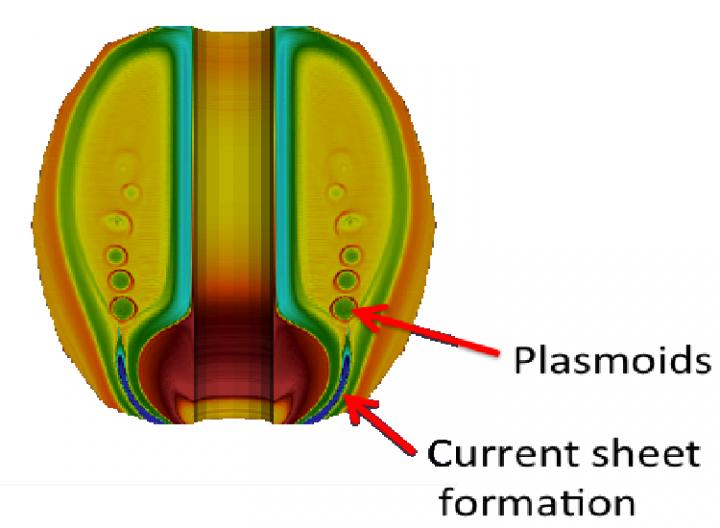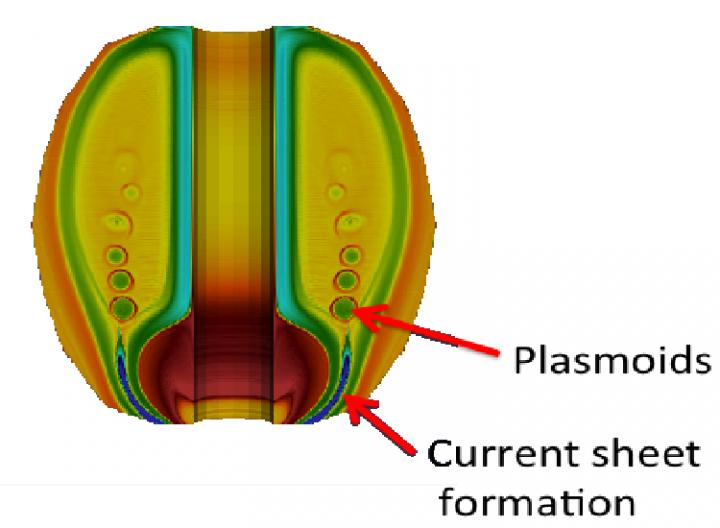
Credit: Fatima Ebrahimi
Physicist Fatima Ebrahimi at the U.S. Department of Energy's (DOE) Princeton Plasma Physics Laboratory (PPPL) has published a paper showing that magnetic reconnection — the process in which magnetic field lines snap together and release energy — can be triggered by motion in nearby magnetic fields. By running computer simulations, Ebrahimi gathered evidence indicating that the wiggling of atomic particles and magnetic fields within electrically charged gas known as plasma can spark the onset of reconnection, a process that, when it occurs on the sun, can spew plasma into space.
That plasma can eventually interact with magnetic fields surrounding the Earth, endangering communications networks and power systems. In fusion facilities, reconnection can help start and confine the plasma that fuels fusion reactions. This research was funded by the DOE's Office of Science (Fusion Energy Sciences) and was published in the December issue of Physics of Plasmas.
Using a computer code developed by researchers at universities and fusion labs, Ebrahimi simulated plasma circulating within a vessel shaped like a doughnut. The vessel mimicked the doughnut shape of fusion facilities called tokamaks. The simulated facility had an opening in its floor for physicists to inject magnetic field lines that would balloon in the tokamak's interior and initiate the fusion process.
Reconnection occurred in the following way. The field lines forming the balloon created an electric current that produced three-dimensional wiggles and wobbles that pushed the open end of the balloon until it closed. At that point, magnetic reconnection occurred and turned the magnetic balloon into a magnetic bubble called a plasmoid that carries electric current.
Ebrahimi is now expanding that research. She is currently looking into how to harness the current to create and confine a fusion plasma without using a large central magnet called a solenoid.
Different conditions can set off the reconnection process. "If the strength of the field lines associated with the original magnetic balloon is not enough on its own to instigate reconnection," Ebrahimi said, "the secondary magnetic wiggles can amplify the magnetic fields at the reconnection site, triggering the event." She is also investigating the amplification of magnetic fields through these secondary three-dimensional magnetic and fluid wiggles known as the dynamo effect.
These findings on the effect of magnetic fields can have a broad impact. "The analysis and the modeling can help us better understand how the reconnection process that is triggered by magnetic perturbations in plasmas can lead to the detachment of magnetic loops on the surface of the sun, or efficient startup for fusion plasmas," Ebrahimi said.
###
PPPL, on Princeton University's Forrestal Campus in Plainsboro, N.J., is devoted to creating new knowledge about the physics of plasmas — ultra-hot, charged gases — and to developing practical solutions for the creation of fusion energy. The Laboratory is managed by the University for the U.S. Department of Energy's Office of Science, which is the largest single supporter of basic research in the physical sciences in the United States, and is working to address some of the most pressing challenges of our time. For more information, please visit science.energy.gov.
Media Contact
Raphael Rosen
[email protected]
@PPPLab
http://www.pppl.gov
############
Story Source: Materials provided by Scienmag



